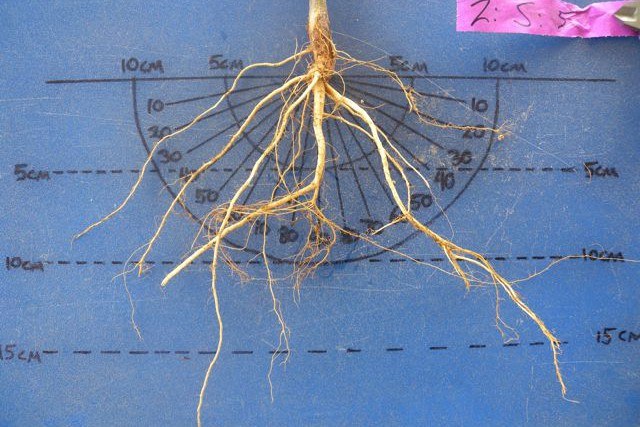We propose to research two new root traits for drought tolerance, Basal Root Growth Angle (BRGA) plasticity in response to soil stress, and Basal Root Whorl Number (BRWN).

Common bean root system with steep basal roots that can tap deeper water
Lead PI: JP Lynch Penn State USA
coPIs: SE Beebe CIAT Colombia
MW Blair CIAT Colombia
K Brown Penn State USA
R Chirwa SABRN Malawi
C Jochua IIAM Mozambique
M Miguel IIAM Mozambique
I Rao CIAT Colombia
Funding Source: Generation Challenge Program
Scientific Summary
The common bean (Phaseolus vulgaris) is the most important food legume on earth. Drought and low soil fertility are primary constraints to bean production in developing countries. We propose to research two new root traits for drought tolerance, Basal Root Growth Angle (BRGA) plasticity in response to soil stress, and Basal Root Whorl Number (BRWN). These traits are specific components of root system architecture that vary substantially among genotypes and play important roles in controlling rooting depth, which is the most important determinant of drought tolerance in bean. A major objective of this project is to rigorously determine the utility of BRGA plasticity and BRWN for plants under water stress and identify potential adaptive tradeoffs for topsoil foraging in low fertility soils. A second objective is to survey Phaseolus germplasm for variation in these traits, to aid breeders in identifying sources and parents. A third objective is to characterize the genetic control of these traits, and to develop molecular markers, which would be especially useful for BRGA plasticity since it is difficult to evaluate phenotypically. These products will be powerful new tools for bean breeders and will also have relevance to the breeding of other crops. The strong QTL identified so far for BRWN may lead to the identification of genes with broad relevance in crop breeding and with potential cross-legume applications as soybean, cowpea and pigeon pea are within the same phylogenetic clade as common bean. This project will generate fundamental new knowledge of root traits that control rooting depth and soil resource acquisition, and will therefore address a critical need in crop breeding for stressful environments.

